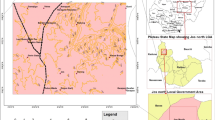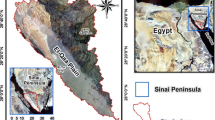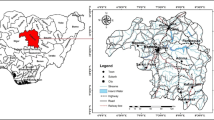ABSTRACT:
A rural groundwater project within the Voltaian Sedimentary Basin in central Ghana was the focus of a study to develop better well-siting strategies, based on interpretations of remote-sensing data and Geographic Information System (GIS) analyses. The drilling success rate of the project had been low due to low primary porosity and the restriction of groundwater to secondary structural features. Remote-sensing data that were incorporated in the study include Landsat Thematic Mapper (TM), SPOT, and infrared aerial photography. These data were interpreted for linear vegetation, drainage, and bedrock features that would indicate underlying transmissive fracture zones. Lineaments were examined in the field and integrated with information from several hundred GPS-positioned boreholes. GIS analyses focused on the identification of phenomena that contributed to successful wells, in order to develop optimal strategies for future well siting. Remote-sensing data allowed effective mapping of features that are conducive to groundwater development. Lineaments identified on Landsat TM imagery had the greatest correspondence to well success. The integration of data in a GIS was valuable for effective analyses but also exposed the necessity of accounting for spatial reference and accuracy of data from different sources. GPS technology proved very useful to increase the spatial accuracy of the various data integrated in the GIS.
RÉSUMÉ:
Un projet d'hydraulique villageoise dans le bassin sédimentaire de la Volta au Ghana central a été le but d'une étude pour développer des stratégies de meilleur positionnement de puits, en s'appuyant sur l'interprétation de données de télédétection et l'analyse de systèmes d'informations géographiques (SIG). Le taux de réussite de forages du projet a été faible à cause de la faible porosité primaire et le faible rendement en eau souterraine dûà des phénomènes structuraux secondaires. Les données de télédétection qui ont été prises en compte comprennent une cartographie thématique Landsat, des images SPOT et une photographie aérienne infrarouge. De ces données ont été tirées des informations sur les alignements de la végétation, du drainage et dans la rouche, indicatrices de zones sous-jacentes de fractures transmissives. Les linéaments ont été examinés sur le terrain en association avec les informations relatives à plusieurs centaines de forages positionnés par GPS. Les analyses par SIG mettent l'accent sur l'identification des phénomènes qui contribuent à la réussite des forages, dans un but de meilleure mise en oeuvre de stratégies de positionnement des futurs puits. Les données de télédétection permettent une cartographie réelle des phénomènes qui produisent l'écoulement souterrain. Les puits réussis correspondent le mieux aux linéaments identifiés sur les images Landsat. L'integration des données à un SIG a été intéressante pour les analyses, mais aussi pour montrer la nécesité de prendre en compte la référence spatiale et la précision des données de différentes origines. La technologie GPS a montré une grande utilité pour améliorer la précision spatiale des différentes données introduites dans le SIG.
RESUMEN:
Un proyecto rural de aguas suberráneas llevado a cabo en la Depresión Sedimentaria Voltaian, en la zona central de Ghana, fue el centro de un estudio para desarrollar unas mejores estrategias de localización de pozos, basados en la interpretación de los datos procedentes de sensores remotos y del análisis de los Sistemas de Información Geográfica (GIS). El índice de éxito de las perforaciones en el proyecto había sido bajo, debido a la baja porosidad primaria y a la restricción del agua subterránea a aspectos estructurales secundarios. Los datos de sensores remotos que se incorporan al estudio incluían el Mapeo Temático Landsat (TM), SPOT y la fotografía aérea infrarroja. Estos datos se utilizaron para caracterizar vegetación, drenaje y lechos rocosos, datos que permiten identificar las zonas de fracturas más transmisivas. Estos lineamientos se examinaron en campo y se integraron con la información procedente de varios cientos de sondeos posicionados mediante GPS. Los análisis GIS se centraron en la identificación de los fenómenos que contribuyeron a que algunos pozos resultaran un éxito, con la idea de desarrollar estrategias óptimas para el posicionamiento de pozos futuros. Los datos de sensores remotos permitieron cartografiar adecuadamente los elementos conductivos principales. Los lineamientos que se identificaron mediante imágenes del Landsat TM son los que tuvieron mayor éxito. La integración de datos en un GIS resultó valiosa para análisis efectivos, pero mostró a su vez la necesidad de tener en cuenta la referencia espacial y la exactitud de los datos procedentes de diversas fuentes. La tecnología GPS resultó muy útil para aumentar la exactitud espacial de los varios datos integrados en el GIS.
Similar content being viewed by others
Author information
Authors and Affiliations
Rights and permissions
About this article
Cite this article
Sander, P., Chesley, M. & Minor, T. Groundwater Assessment Using Remote Sensing And GIS In A Rural Groundwater Project In Ghana: Lessons Learned. HYJO 4, 40–49 (1996). https://doi.org/10.1007/s100400050086
Published:
Issue Date:
DOI: https://doi.org/10.1007/s100400050086




